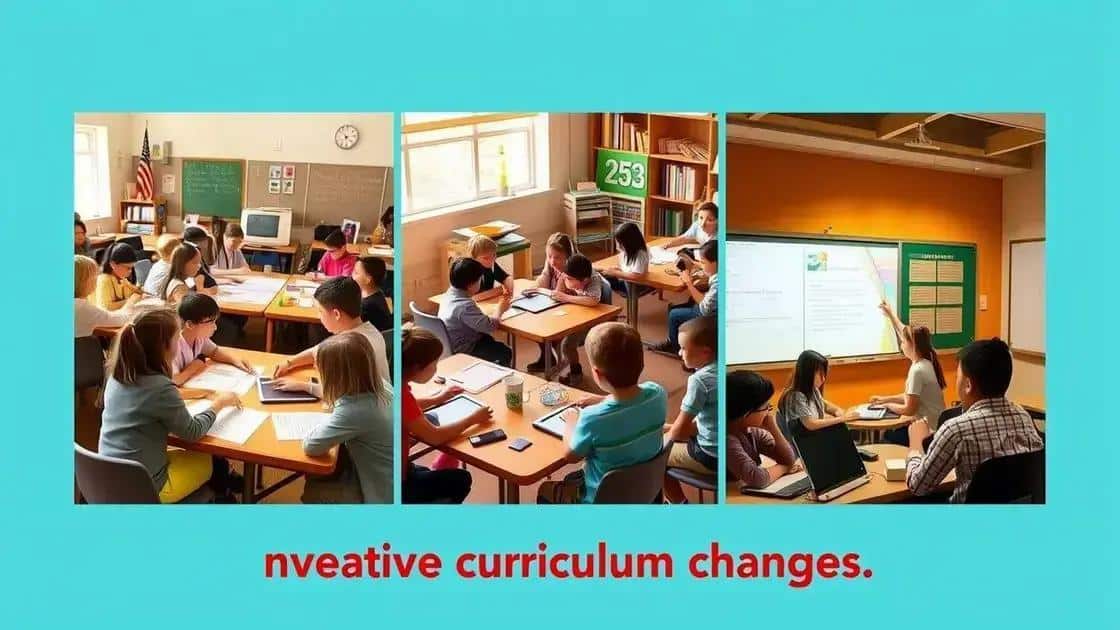Curriculum reforms: transforming education for future generations

Anúncios
Curriculum reforms enhance student engagement, promote inclusivity, and equip learners with essential skills for the future through innovative practices and effective implementation strategies.
Curriculum reforms are essential to adapt our education system to the needs of today’s learners. Have you ever considered how changes in curricula can influence student success? Let’s dive into this crucial topic.
Understanding curriculum reforms
Understanding curriculum reforms is crucial for educators and policymakers. Changes in the curriculum can significantly impact student engagement and learning outcomes.
Curriculum reforms often aim to make education more relevant and accessible. When schools update their curricula, they not only include current knowledge but also engage students in meaningful ways. For instance, integrating technology in the learning process fosters a more interactive environment.
Key Elements of Curriculum Reform
Successful curriculum reform involves various components:
- Alignment with modern educational standards
- Focus on critical thinking and problem-solving skills
- Incorporation of diverse perspectives
- Support for teacher training and resources
These elements help create a more dynamic learning experience. By focusing on these key aspects, educators can better prepare students for future challenges.
The role of curriculum reforms goes beyond mere updates. They encourage collaboration among educators, administrators, and the community. When stakeholders actively participate in the process, the reforms become more comprehensive and effective. The collective input ensures that the curriculum reflects the needs of all learners.
Importance of Feedback in Curriculum Reforms
Feedback is a vital part of the reform process. Gathering insights from students, teachers, and parents can lead to improvements in the curriculum. Regular assessment of the new curriculum allows for adjustments that enhance its effectiveness.
By acknowledging the importance of feedback, schools can cultivate an environment where curriculum reforms thrive. Continuous improvement leads to more relevant educational practices that inspire students to engage actively in their learning.
Key benefits of updated curricula

Updated curricula provide numerous advantages that can enhance the educational experience for students. One of the most significant benefits is the promotion of critical thinking. By encouraging students to evaluate information and engage in discussions, schools help build their ability to think independently and creatively.
Enhanced Student Engagement
A well-structured curriculum can lead to higher levels of student engagement. When lessons are relevant and interesting, students are more likely to participate actively. This increases motivation and helps learners connect with the material.
- Incorporation of real-world problems
- Use of diverse learning methods
- Collaboration through group projects
These methods can make learning enjoyable and enrich students’ experience. Moreover, focusing on real-world issues allows students to apply their knowledge in practical ways, making the content more relatable.
Another advantage of updated curricula is the emphasis on diversity and inclusion. A relevant curriculum reflects different backgrounds and perspectives, ensuring all students feel represented. This approach fosters a sense of belonging and validates various experiences among learners.
Preparation for the Future
Lastly, current curricula prepare students for future challenges. By teaching skills essential for the modern workforce, such as digital literacy and collaboration, schools equip students with tools they need to succeed beyond their education. This not only enhances their employability but also builds resilience in facing evolving job markets.
Overall, updated curricula play a vital role in shaping well-rounded individuals ready to contribute positively to society. The benefits extend beyond academic achievements, nurturing skills necessary for personal growth and community engagement.
Challenges in implementing curriculum changes
Implementing curriculum changes can present significant challenges for educators and institutions. One primary obstacle is resistance to change. Many teachers and administrators may feel comfortable with existing practices and may find it difficult to adopt new approaches. This reluctance can lead to a lack of enthusiasm for reform efforts.
Inadequate Training and Support
An important factor in successful implementation is the training provided to educators. When teachers are not adequately prepared or supported, they may struggle to apply new curricula effectively. Professional development programs should be tailored to equip educators with the necessary skills and knowledge.
- Workshops to introduce new materials
- Ongoing mentorship programs
- Access to educational resources
These elements are crucial for enabling teachers to feel confident and competent in their roles during the transition. Without this support, the changes made to the curriculum may not yield the desired results.
Another significant challenge involves aligning curricula with standardized testing requirements. Many schools face pressure to produce high test scores, which can conflict with innovative instructional methods. This focus on testing can limit teachers’ flexibility to explore creative teaching strategies.
Resource Allocation
Furthermore, implementing curriculum changes often requires significant financial resources. Schools may need to invest in new materials, technology, and training programs. For many districts operating on tight budgets, securing funding can become a major hurdle. This limitation can hinder efforts to adopt and sustain effective reforms.
Addressing the various challenges associated with curriculum changes is vital for a successful implementation. Stakeholders must work together, fostering a supportive culture where educators feel empowered to embrace change. By acknowledging these obstacles, schools can create strategic plans that enhance the implementation process and promote positive outcomes for all students.
Successful case studies in curriculum reform

Successful case studies in curriculum reform showcase how effective changes can lead to improved educational outcomes. Several schools and districts have made significant strides by adopting innovative practices that engage students and enhance learning experiences.
Case Study 1: Innovative School District
One notable example is an innovative school district that revamped its curriculum to incorporate project-based learning. This shift allowed students to work on real-world problems, promoting not only engagement but also critical thinking skills. By offering hands-on projects, students were able to connect their classroom learning to practical applications.
- Increased collaboration among students
- Development of problem-solving skills
- Higher student motivation and attendance
These outcomes highlight the positive impact of focusing on practical learning experiences. By emphasizing collaboration and real-world relevance, students felt more invested in their education.
Case Study 2: Diverse Curriculum Implementation
Another successful case study involves a school that incorporated a diverse curriculum aimed at reflecting the backgrounds of all its students. This approach not only engaged learners but also fostered a sense of belonging. When students see their cultures represented, they are more likely to connect with the material and excel.
Teachers received professional development to better understand the importance of inclusivity in their teaching methods. By evaluating their practices, they could create lessons that cater to a broader range of perspectives.
Shifting to a more inclusive curriculum resulted in improved academic performance and a positive school culture. Students reported feeling respected and valued, which contributed to their overall success.
Case Study 3: Technology Integration
A third example features a high school that effectively integrated technology into its curriculum. By using digital tools, teachers enhanced student learning through interactive lessons and instant feedback. They emphasized using technology not only as a teaching aid but also as a critical component of students’ futures.
- Enhanced digital literacy skills
- Immediate access to resources and information
- Increased student engagement through gamified learning
This shift prepared students for the digital demands of the workforce, allowing them to thrive in a technology-driven environment.
These successful case studies in curriculum reform illustrate the importance of innovative approaches in education. By focusing on practical application, inclusivity, and technology, schools can create a dynamic learning environment that benefits all students.
FAQ – Frequently Asked Questions about Curriculum Reforms
What are the main benefits of curriculum reforms?
Curriculum reforms enhance student engagement, promote inclusivity, and prepare students for future challenges by developing critical skills.
How can schools effectively implement curriculum changes?
Effective implementation involves providing adequate training for teachers, ensuring support from all stakeholders, and aligning the curriculum with educational standards.
Can you give examples of successful curriculum reform?
Successful reforms often feature project-based learning, a diverse curriculum reflecting different cultures, and the integration of technology into lessons.
What challenges do schools face in curriculum reform?
Common challenges include resistance to change, inadequate training, funding limitations, and the pressure to meet standardized testing requirements.






